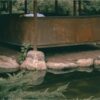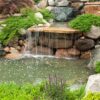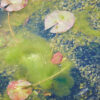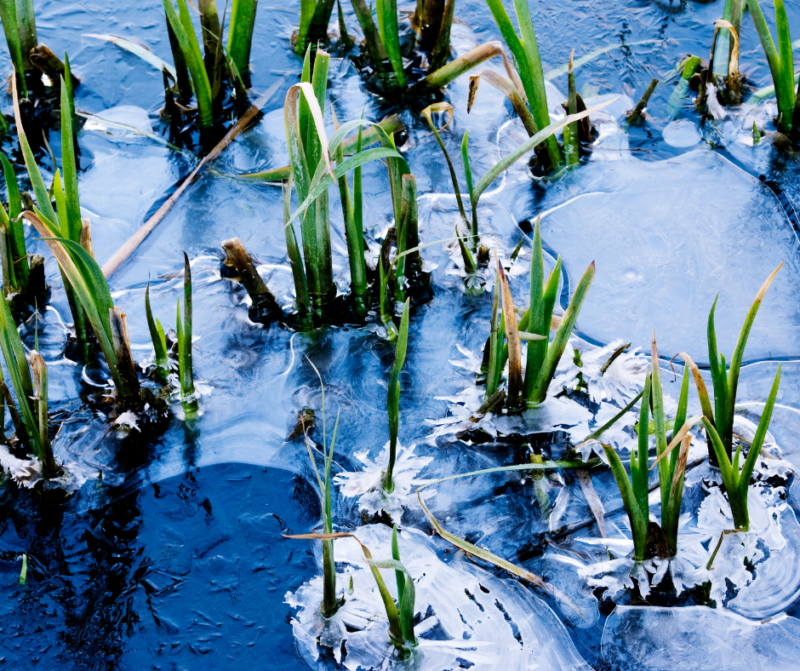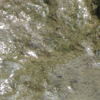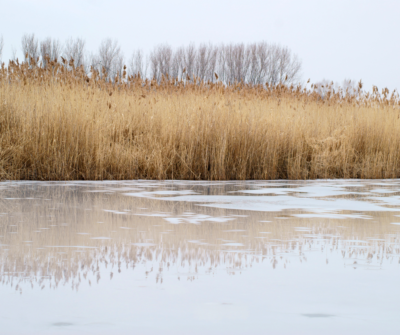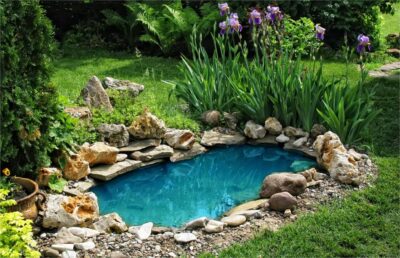Does a Wildlife Pond Need a Pump?
Although wildlife ponds are known for sustaining their flora and fauna through an organic and natural ecosystem that consists of a natural oxygen and nitrogen cycle, sometimes, there is need of further aeration and oxygenation for the maintenance of optimal conditions in a wildlife pond.
Pond pumps perform two vital functions: oxygenation and aeration. Before discussing a wildlife pump’s relevancy in a wildlife pond, we must first differentiate between oxygenation and aeration, as they are often confused to be similar operations.
What is Oxygenation
Oxygenation can be considered to be a by-product of aeration because oxygenation is the natural and effective provision of oxygen to the pond. It comes naturally with a pond, however aeration enhances the rate of oxygenation in a pond as oxygen is efficiently provided to certain areas of a pond that were previously deprived of their oxygen requirement.
A common example of an oxygenator would be an air pump, which is tasked to supply sheer levels of oxygen to the pond. Even though air pumps are also known for their aeration capabilities, they are primarily known for their oxygenation feature.
What is Aeration
Aeration is the process of improving the movement of water. The improved movement allows for nutrients, oxygen, and air to be evenly distributed to all regions of a pond. Since aeration increases the surface area of the pond’s water due to constant movement, it significantly increases gas exchanges taking place at the surface of the water, allowing plenty of oxygenation to take place.
The best example for aerators would be natural fountains and waterfalls in a pond because they create substantial movement of water within a pond.
Now that we know the differences between oxygenation and aeration, let us talk about their importance in a wildlife pond.
The Significance of Oxygenation and Aeration in a Wildlife Pond
Oxygenation is vital for the survival of every living organism inside and outside your pond. Specifically, for fish, oxygen is the most vital part of their survival, hence a slight drop in oxygen supply within the pond can prove to be fatal for the fish as their oxygen requirement is the highest.
Even though wildlife ponds usually do not contain any fish, they still need a steady supply of oxygen to maintain the natural and fragile ecosystem found underneath the surface level. The existence of a wildlife pond is due to microscopic bacteria found everywhere in it. If these bacteria and other microorganisms living inside a pond were deprived of oxygen, they would rapidly die.
When the pond’s bacteria die, the natural nitrogen and oxygen cycle will halt, resulting in a pond becoming stagnant. Once stagnant, the pond will quickly succumb to algae booms and sludge because the vital bacteria is not present to decompose dead organisms and debris.
Stagnant ponds are ideal breeding grounds for mosquitoes and flies, hence, if you want to prevent those nasty mosquitoes ruining your precious days and nights, you need to oxygenate and aerate your pond as these processes annihilate mosquito nests.
Aeration also plays a vital role in maintaining a wildlife pond’s health as it promotes a competent oxygenation level for a pond. It also ensures an able and continuous gas exchange at the pond’s surface, ensuring that key natural processes, such as photosynthesis and the nitrogen cycle, are happening smoothly. Aerated ponds also greatly decrease the risk of contracting algae blooms and abnormal sludge creations because organic activity is optimized.
How to Naturally Oxygenate a Wildlife Pond
If you do not have ornamental fish, such as goldfish and koi, inside your wildlife pond, you can easily oxygenate it using the mighty force of nature; there is no need for a pump when a pond does not contain any fish.
Equip your Pond with a Fountain
Since pond fountains are now enabled for use with solar power, you do need to bother with a mains electricity switch to operate your fountain; let natural powers work wonders. Pond fountains are excellent natural aerators, thus being superb oxygenators as well. How? Since pond fountains promote the natural and continuous flow of water, the waves created by this flow provide substantial aeration to a natural wildlife pond.
Pond fountains are a one-time investment, bearing fruit for a long time given they are properly maintained.
Man-made Waterfall for Enormous Aeration
A waterfall with a decent size is ideal for your wildlife pond’s aeration needs because of a strong and constant flow of water, all year round. Although this method requires a great deal of effort to set up, it can remove all your aeration and oxygenation worries.
The Easiest Way: Pond Plants
If planted in larger numbers, pond plants have the ability to naturally aerate and oxygenate a small or medium pond in a cost-effective and eco-friendly manner. Apart from having several other benefits for your pond, such as being natural hatcheries for fish and friendly bacterial colonies, they are also known for their natural filtration properties as they absorb excessive nutrients, such as nitrates and phosphates from the substrate (waterbody). If these inorganic compounds consisting of phosphates and nitrates, that are produced by bacteria during their decomposing activities, are not broken down, they will act as fertilizing agents for multiplied algae growth and sludge creation at the bottom.
Experts consider submerged species, such as Hornwort, to be the most useful oxygenator because they release oxygen inside the waterbody instead of releasing it in the outer atmosphere similar to floating species, such as water lilies.
This allows necessary aeration in the waterbody to be achieved as water clarity is increased due to constant water purification from these aquatic plants.
Additionally, plants also act as apt hiding places for certain fish types, such as catfish. Goldfish love to chomp on certain species of aquatic plants, keeping the plants’ growth in check.
In conclusion, plants will never parallel the oxygenation and aeration levels produced by pumps and filtration systems, however they are fully capable to complement these man-made systems in an economical and effective manner.
Pond Pumps; The What and When
Pond pumps are primarily used in ponds that contain fish, especially ornamental ponds that house fish such as koi and goldfish. These types of fish have high oxygen needs, and can not survive in ponds that are not properly aerated.
Pond pumps serve the key role of aerating and oxygenating the pond. They operate by continuously pushing the water through force. This acceleration of water allows it to spread evenly, all over the pond’s surface.
The reason why pond pumps are crucial for sustaining aquatic life is because they prevent pond water from becoming stagnant; if a pond is stagnant, the nutrients present in the water will not be readily and equally distributed for aquatic life.
Proper aeration through the pumping action also prevents algae blooms and overwhelming production of sludge inside the pond.
Ponds with Fish Need Pumps and a Filtration System
If we are talking about a wildlife pond that does not include fish, a pump is not necessary because it can easily sustain itself through the natural ecosystem that lives inside. However, a pond having fish, but not a pump and filtration system, can inevitably prove to be disastrous in the near future.
Fish constantly produce waste that remains inside a pond if proper aeration and filtration is not provided by a pump. Soon, the waste will cause the water to turn toxic. This toxic environment will not allow the aquatic life to thrive, instead it will prove to be fatal for it as the fish will be the first to die in a short timespan.
Considering the size and depth of your pond, you will have to equip it with a necessary pump. Sometimes, pond owners have 1 or 2 extra supplemental pumps since their ponds are of a considerable size.
Artificial backyard ponds that house fish also need a proper filtration system which will prevent algae and harmful bacteria from gaining popularity inside the water.
Pond Pump
Why do Natural (Wildlife) Ponds do not Need Pumps
Natural ponds consist of a properly functioning ecosystem that sustains itself. This ecosystem consists of aquatic plants, bacteria, insects, fish, et cetera. The organic ecosystem sustains itself by keeping oxygen and nutrient levels up to the desired rate and algae levels low.
Following natural oxygen and nitrogen cycles, when a living organism dies inside a wildlife pond, it is naturally decomposed by bacteria inside the pond. This decomposition provides vital nutrients to the pond’s wildlife to ensure its survival.
The reason why most healthy wildlife ponds are able to thrive without any human or mechanical intervention is because the nutrients produced by the decomposition process are quickly consumed by the aquatic life before algae can take full advantage of them. Hence, algae blooms are naturally curtailed.
Natural wildlife ponds have no linings at the bottom, unlike artificial backyard ponds. Since wildlife ponds have soil at the bottom, their nutritional requirements are further met by the large amount of soil at the surface.
Oxygenation is not a problem with such ponds because there is a plentiful amount of aquatic plants that naturally oxygenate the pond. Besides, since wildlife ponds usually do not have fish, their oxygen and aeration needs are minimal.
The Power of Solar Energy
If you do not want to use electricity and reduce your carbon footprint while keeping your pond properly aerated and oxygenated since it contains ornamental fish like koi and goldfish, you can use a wide range of solar products for your pond. These include: a solar power pump and solar power aeration system.
Solar power pumps are ideal for small to mid-sized ponds as you will only need one to get the job done. These pumps usually come in the range of 50-400 GPH, providing you with substantial water height and flow. They are enough to ensure that the necessary aeration is received by your pond.
When you experience overcast conditions, you can easily use the backup battery packs that come with these solar power pumps; they will provide you with an additional 4 to 6 hours of runtime.
Solar power aerators are able to directly provide oxygen to your pond. They operate above the water, on each side of your pond. The vital oxygen is provided using diffuser stones that are placed at the bottom surface of your pond. These stones can directly diffuse oxygen from the bottom, all the way to the top surface of your pond.
Since these aerators do not require electricity, they can be placed anywhere around the pond, no matter how many your pond requires. Even though they are aerators, they provide oxygen along with aerating your pond to prevent growth of algae and an even distribution of nutrients.
Solar Power Aerator
For these solar products for your wildlife pond, you will need large solar panels that will capture greater amounts of solar energy.
Solar Power Pond Pump
Concluding Remarks
In conclusion, whether you should equip your pond with pumps and aerators comes down to the pond type. If your concern is a wildlife pond, you will be better off with using no pumps and aerators as you let mother nature do its wonders. The natural ecosystem of a wildlife pond is harmonious and self-sustaining. If you feel the need for extra care, you can always equip your wildlife pond with solar-powered pumps and aerators.
However, if we are talking about a backyard artificial pond, the need for pumps and aerators is evident and crucial because ornamental fish, such as koi and goldfish, require sufficient amounts of oxygen and aeration to survive and thrive since they create enormous waste.


